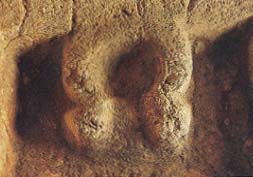Image Details

Richard Nowitz
Headrests for the dead were carved from stone burial benches in two Jerusalem cave tombs from the First Temple period. Typical headrests were a simple, raised horseshoe shape (see photograph). However, this headrest is markedly different. The thick, raised headrest with curved ends—which reminds the author of the wig worn by the Egyptian goddess Hathor—is a sample of the headrests found only in Cave Complex II at St. Étienne (see drawing).
Could the thicker, curved headrest reflect Mesopotamian religious imagery, as Othmar Keel has suggested, and not merely an Egyptian artistic motif, as St. Étienne’s excavator Gaby Barkay argues? Impossible, says Barkay. The Israelites’ view of death was incompatible with that of the earlier Mesopotamians.
